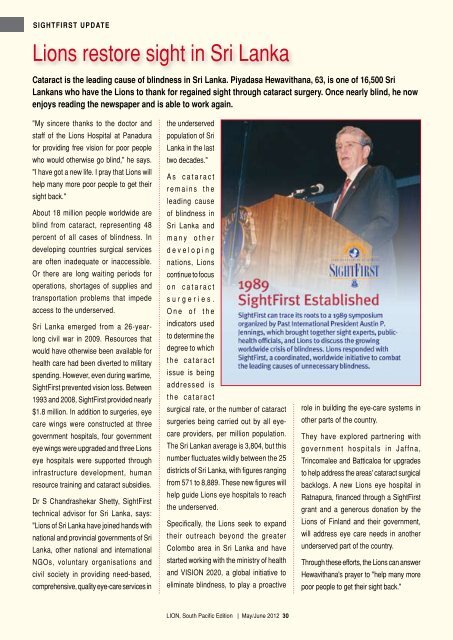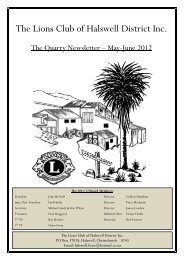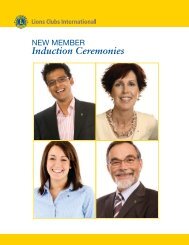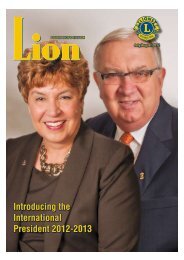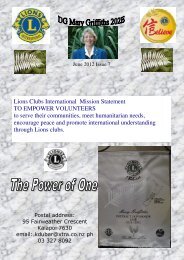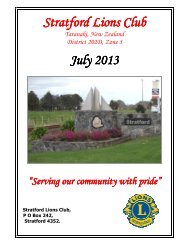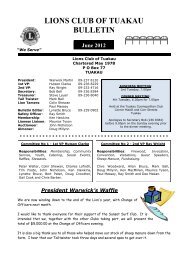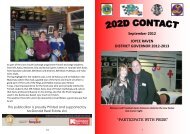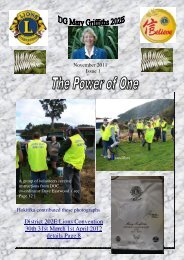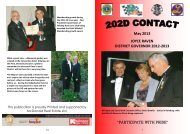SIGHTFIRST UPDATE<strong>Lions</strong> restore sight in Sri LankaCataract is the leading cause of blindness in Sri Lanka. Piyadasa Hewavithana, 63, is one of 16,500 SriLankans who have the <strong>Lions</strong> to thank for regained sight through cataract surgery. Once nearly blind, he nowenjoys reading the newspaper and is able to work again."My sincere thanks to the doctor andstaff of the <strong>Lions</strong> Hospital at Panadurafor providing free vision for poor peoplewho would otherwise go blind," he says."I have got a new life. I pray that <strong>Lions</strong> willhelp many more poor people to get theirsight back."About 18 million people worldwide areblind from cataract, representing 48percent of all cases of blindness. Indeveloping countries surgical <strong>service</strong>sare often inadequate or inaccessible.Or there are long waiting periods foroperations, shortages of supplies andtransportation problems that impedeaccess to the underserved.Sri Lanka emerged from a 26-yearlongcivil war in 2009. Resources thatwould have otherwise been available forhealth care had been diverted to militaryspending. However, even during wartime,SightFirst prevented vision loss. Between1993 and 2008, SightFirst provided nearly$1.8 million. In addition to surgeries, eyecare wings were constructed at threegovernment hospitals, four governmenteye wings were upgraded and three <strong>Lions</strong>eye hospitals were supported throughinfrastructure development, humanresource training and cataract subsidies.Dr S Chandrashekar Shetty, SightFirsttechnical advisor for Sri Lanka, says:"<strong>Lions</strong> of Sri Lanka have joined hands withnational and provincial governments of SriLanka, other national and internationalNGOs, voluntary organisations andcivil society in providing need-based,comprehensive, quality eye-care <strong>service</strong>s inthe underservedpopulation of SriLanka in the lasttwo decades."As cataractremains theleading causeof blindness inSri Lanka andmany otherdevelopingnations, <strong>Lions</strong>continue to focuson cataractsurgeries.One of theindicators usedto determine thedegree to whichthe cataractissue is beingaddressed isthe cataractsurgical rate, or the number of cataractsurgeries being carried out by all eyecareproviders, per million population.The Sri Lankan average is 3,804, but thisnumber fluctuates wildly between the 25districts of Sri Lanka, with figures rangingfrom 571 to 8,889. These new figures willhelp guide <strong>Lions</strong> eye hospitals to reachthe underserved.Specifically, the <strong>Lions</strong> seek to expandtheir outreach beyond the greaterColombo area in Sri Lanka and havestarted working with the ministry of healthand VISION 2020, a global initiative toeliminate blindness, to play a proactiverole in building the eye-care systems inother parts of the country.They have explored partnering withgovernment hospitals in Jaffna,Trincomalee and Batticaloa for upgradesto help address the areas' cataract surgicalbacklogs. A new <strong>Lions</strong> eye hospital inRatnapura, financed through a SightFirstgrant and a generous donation by the<strong>Lions</strong> of Finland and their government,will address eye care needs in anotherunderserved part of the country.Through these efforts, the <strong>Lions</strong> can answerHewavithana's prayer to "help many morepoor people to get their sight back."LION, South Pacific Edition | May/June 2012 30
NOTICES/OBITUARIESMargaret COURT 1934-2011Margaret joined the Waimate Whitehorse<strong>Lions</strong> Club in September 1992, alwaysgot 100% attendance and was an activemember on the projects, catering, social/programme, health & welfare and publicitycommittees. Margaret loved having a chatwith her fellow <strong>Lions</strong> members and had agreat sense of humour. She loved knittingand her garden was her pride in joy; shewas an active member of the WaimateGarden Club. In the later years Margaretsuffered ill health but was always willingto do an hour or two selling tickets on ourraffle days. Margaret had three sons (onedeceased) and very supportive daughtersin-law.She was a much-loved grandmotherand great grandmother.Colin MacKenzie HILL 1937-2011Colin was born in Wellington, trained as aplumber and became his own boss early inhis working life. He joined Tawa <strong>Lions</strong> asa charter member in 1966 and served hisclub and community with distinction for 45years of perfect attendance. Colin servedas an elected officer for 20 of those yearsincluding president 1971/72 and eleventerms as a director. He introduced ninenew members, convened the club's 25thanniversary celebrations, co-convened theNZ 2000 Book Project supporting CampQuality, and became a Melvin Jones Fellowin 2000. Colin achieved much in Tawa <strong>Lions</strong>and his community with notable support toTawa Kindergarten, Tawa College and theTawa Volunteer Fire Brigade. He is survivedby his wife Barbara, daughters Caroline andVivienne and their families.Tuckwell Clifton (Cliff) KEITH 1938-2012As a member of the Karori <strong>Lions</strong> Club (1968-1972) Cliff believed there was a need for aclub closer to home in Northland and theadjacent suburb of Wilton, and was able toget Karori <strong>Lions</strong> to sponsor the new Tinakori<strong>Lions</strong> Club in 1977. As a charter member ofthe club, Cliff was instrumental in seeking out anumber of projects both locally and of nationalsignificance; notably recognition of the needto provide assistance to the Cystic FibrosisAssociation of <strong>New</strong> Zealand where <strong>Lions</strong><strong>Clubs</strong> throughout <strong>New</strong> Zealand raised a totalof $56,000 to fund a researcher, ProfessorBob Elliott. Cliff is survived by his wife Diana,daughter Joanna and son Christopher.Rex John WHITING 1935-2011Born at Hinds and educated at Hinds andAshburton schools, John left school to workon his parents' and neighbouring farms. Hethen commenced farming on his own land,and became a very accomplished stockmanespecially in his knowledge of sheep farming.His keen interests in rugby and horse racingwere among his many leisure pursuits. As aCharter member of Hinds & Districts LionClub in 1984, John became the first directorof Programme and Social, then moved onto 2nd VP 1985, 1st VP 1986, and presidentin 1987. Other directorships followed in lateryears. John will be remembered as a valuedmember of the club who could always berelied upon to attend working bees, sellraffles, and contribute to the successfulrunning of the club. John is survived by hiswife Cecelia, the current president of the<strong>Lions</strong> Club of Ashburton County, and hisfour daughters.Alan (Arnie) WRIGHTAlan joined <strong>Lions</strong> as a charter memberof the Otago Peninsula Club in 1975. Hetransferred to Te Anau in 1981, servinga term as president. He returned to thePeninsula in 1989, serving as president,director (twice) and youth affairs chairman.Alan was a very active member with almost100% attendance right up until he had tomove to the Montecillo Veterans Home.Alan wil be most remembered as the DOCranger and his work with the albatross atTaiaroa Heads. So successful were Alanand his wife Connie, they were asked tomove to Te Anau to organise a programmefor the survival of the takahe. Alan receivedthe highest of accolades at his funeral whenhe was accorded the honour of havingalbatross feathers grace his coffin - a realgift from the local Maori rununga to a manwho helped save both these precious birds.Alan is survived by Connie, three childrenand their families.STRATFORD LIONS CLUB - 50TH CHARTERANNIVERSARYOn 11 March 1963 the then World President of<strong>Lions</strong> International, Curtis D Lovill of Main, USA,attended a function at the Stratford War MemorialHall to present the Charters to three new <strong>Lions</strong><strong>Clubs</strong> in the Taranaki area - <strong>New</strong> Plymouth ,Stratford and Hawera.On Saturday 23 February 2013 the Stratford <strong>Lions</strong>Club is to celebrate the 50th Anniversary of thishistoric event and is looking for expressions ofinterest from all past members and supporters of allthree clubs chartered at that time. Please forwardcontact details to the club at P O Box 242, Stratford4352 or email deaths@xtra.co.nz for inclusion infuture communication of activities planned. Weare interested in hearing from anyone who hasinformation on past members or holds details ofclub activities throughout the past 50 years.Peter DeathOn behalf of the organising committee. The only agent licensed in NZ byInternational to apply the <strong>Lions</strong> logo.. We can print or embroider ontogarments as well.. Contact: Dex 027 614 3570Jonno 07 886 0867banners@tokoroalions.comLION, South Pacific Edition | May/June 2012 31


